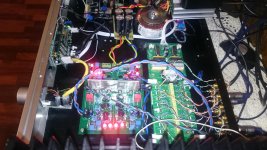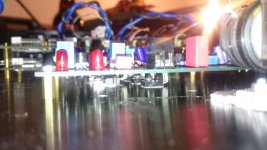You can screw the transistors to the chassis, then slip the board over them and solder. It you screw them from the underside into a tapped bar they would be removable later.
I guess that's the best way to do it. I suspect that I cut the transistor legs too short to move them under the board so I will decrease the bias first to test if it will play music before moving the transistors. 😉
I put 100r resistors in series with r22, r23, 32 and 33. Now the heatsink run stable at 59C. That's more then I'm comfortable with, but it's ok for testing.
It plays music through spooky ips and 5p Slewmonster and works fine. It seems to be more neutral then the dcb1 buffer, but it's hard to say since I haven't listened to my stereo for a couple of days.
It plays music through spooky ips and 5p Slewmonster and works fine. It seems to be more neutral then the dcb1 buffer, but it's hard to say since I haven't listened to my stereo for a couple of days.
Attachments
I did check mouser & digikey and I cannot find BC560 .. ??
In fact ... TO-92 stock is falling ... surface mount stock is climbing ..
Ca somebody give me the name of a supplier .. for these transistors ... please
In fact ... TO-92 stock is falling ... surface mount stock is climbing ..
Ca somebody give me the name of a supplier .. for these transistors ... please
Looks like everyone is ditching the TO92's. The company I used to work for up until about 1 mpnth ago, got out of that business in 2006/2007 - no money in it (i.e. the TO-92 package).
Time to get used to soldering SOT23's! Easy to do if you use a fine tipped soldering iron and some 0.8mm solder.
Time to get used to soldering SOT23's! Easy to do if you use a fine tipped soldering iron and some 0.8mm solder.
I like SMT too, but it seems not too many other do. I prefer to use a reflow oven over an iron though.
I am soldering down .5 mm pitch IC's with an iron. How are you re-flowing?
When I used to hand etch, I just used a toaster oven. I liked how parts would self align themselves.
Since I've switched to Chinese boards I've ran into problems with parts moving while baking. I think I'm trapping air under the parts due to the silkscreen outlines under the parts. I'm in the process of building a better temperature controller and I'm liking going to need to use stencils for the paste.
I finally got around to mount the transistors on the chassis below the board. Now it runs cool and I can put the lid on. 🙂
How does it sound? Is your volume changes still pop free?
How does it sound? Is your volume changes still pop free?
It sounds great! I have been using it for a while using a big heatsink clamped to the small aluminium sink before I relocated the transistors, no pops or other noise.
It took a while to get used to the sound compared to the dcb1 buffer, the pitchfork sounds more transparent.
It really brings the slewmaster to life when I crank the volume. 🙂
I want to give a try to line stage if i can find the pcb .
I'm not really happy with the layout of the linestage. It works great, but it's hard to cool the output transistors. It's going to get changes to make it easier to mount it to a heat sink.
To have a new layout you may start with this ..single sided ..
Power suplly in the center an audio on each side .. an a few jumper
THere is also a track at ground level to work as a gard betwen sections
All power transistor in a single line to fit heatsink.
Power suplly in the center an audio on each side .. an a few jumper
THere is also a track at ground level to work as a gard betwen sections
All power transistor in a single line to fit heatsink.
Attachments
- Home
- Source & Line
- Analog Line Level
- Pitchfork pre-amplifier



